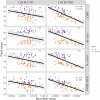Association between white matter microstructure and cognitive function in patients with methamphetamine use disorder
- PMID: 35838008
- PMCID: PMC9842920
- DOI: 10.1002/hbm.26020
Association between white matter microstructure and cognitive function in patients with methamphetamine use disorder
Abstract
Methamphetamine use disorder (MUD) has been associated with broad neurocognitive impairments. While the cognitive impairments of MUD have been demonstrated, the neuropathological underpinnings remain inadequately understood. To date, the published human diffusion tensor imaging (DTI) studies involving the correlation between diffusion parameters and neurocognitive function in MUD are limited. Hence, the present study aimed to examine the association between cognitive performance and white matter microstructure in patients with MUD. Forty-five patients with MUD and 43 healthy controls (HCs) completed their demographic information collection, cognitive assessments, and DTI imaging. DTI images were preprocessed to extract fractional anisotropy (FA), mean diffusivity (MD), axial diffusivity (AD), and radial diffusivity (RD) of various fiber tracts. Univariate tests were used to examine group differences in cognitive assessments and DTI metrics. Linear regression was used to examine the relationship between these two metrics. The results revealed that patients with MUD had lower subset scores of the MATRICS Consensus Cognitive Battery (MCCB), which reflects five cognitive domains: processing speed, attention, verbal learning, visual learning, problem-solving. Patients with MUD also had significantly higher AD, MD, and RD values of the left superior longitudinal fasciculus than HCs. Furthermore, the RD value of the left superior longitudinal fasciculus was a significant predictor of processing speed and problem-solving ability, as shown by the digit-symbol coding test and NAB-Mazes scores, respectively. Findings extended our understanding of white matter microstructure that is related to neurocognitive deficits in MUD and provided potential targets for the prevention and treatment of this chronic disorder.
Keywords: diffusion tensor imaging; methamphetamine use disorder; neurocognition; problem solving; processing speed; superior longitudinal fasciculus; white matter.
© 2022 The Authors. Human Brain Mapping published by Wiley Periodicals LLC.
Conflict of interest statement
The authors declare no conflicts of interest.
Figures


Similar articles
-
A diffusion MRI study of brain white matter microstructure in adolescents and adults with a Fontan circulation: Investigating associations with resting and peak exercise oxygen saturations and cognition.Neuroimage Clin. 2022;36:103151. doi: 10.1016/j.nicl.2022.103151. Epub 2022 Aug 12. Neuroimage Clin. 2022. PMID: 35994923 Free PMC article.
-
Abnormal white matter microstructure in drug-naive first episode schizophrenia patients before and after eight weeks of antipsychotic treatment.Schizophr Res. 2016 Apr;172(1-3):1-8. doi: 10.1016/j.schres.2016.01.051. Epub 2016 Feb 3. Schizophr Res. 2016. PMID: 26852402
-
Axonal deficits in young adults with High Functioning Autism and their impact on processing speed.Neuroimage Clin. 2014 Feb 7;4:417-25. doi: 10.1016/j.nicl.2014.01.014. eCollection 2014. Neuroimage Clin. 2014. PMID: 24624327 Free PMC article.
-
White matter integrity and cognitive performance in children with prenatal methamphetamine exposure.Behav Brain Res. 2015 Feb 15;279:62-7. doi: 10.1016/j.bbr.2014.11.005. Epub 2014 Nov 12. Behav Brain Res. 2015. PMID: 25446763 Free PMC article.
-
Uncovering transcriptomic biomarkers for enhanced diagnosis of methamphetamine use disorder: a comprehensive review.Front Psychiatry. 2024 Jan 8;14:1302994. doi: 10.3389/fpsyt.2023.1302994. eCollection 2023. Front Psychiatry. 2024. PMID: 38260797 Free PMC article.
Cited by
-
Brain dysfunctions and neurotoxicity induced by psychostimulants in experimental models and humans: an overview of recent findings.Neural Regen Res. 2024 Sep 1;19(9):1908-1918. doi: 10.4103/1673-5374.390971. Epub 2023 Dec 15. Neural Regen Res. 2024. PMID: 38227515 Free PMC article.
-
Interactive effect of BDNF rs10835210 polymorphism and childhood maltreatment on cognitive functioning in Chinese male patients with methamphetamine use disorder.Eur Arch Psychiatry Clin Neurosci. 2025 Jun 28. doi: 10.1007/s00406-025-02038-4. Online ahead of print. Eur Arch Psychiatry Clin Neurosci. 2025. PMID: 40580351
-
Imaging neuroinflammation in individuals with substance use disorders.J Clin Invest. 2024 Jun 3;134(11):e172884. doi: 10.1172/JCI172884. J Clin Invest. 2024. PMID: 38828729 Free PMC article. Review.
References
-
- Beard, C. L. , Schmitz, J. M. , Soder, H. E. , Suchting, R. , Yoon, J. H. , Hasan, K. M. , Narayana, P. A. , Moeller, F. G. , & Lane, S. D. (2019). Regional differences in white matter integrity in stimulant use disorders: A meta‐analysis of diffusion tensor imaging studies. Drug and Alcohol Dependence, 201, 29–37. 10.1016/j.drugalcdep.2019.03.023 - DOI - PMC - PubMed
Publication types
MeSH terms
Substances
LinkOut - more resources
Full Text Sources
Medical
Miscellaneous

